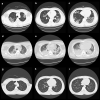Comparison of patients hospitalized with COVID-19, H7N9 and H1N1
- PMID: 33261654
- PMCID: PMC7707904
- DOI: 10.1186/s40249-020-00781-5
Comparison of patients hospitalized with COVID-19, H7N9 and H1N1
Abstract
Background: There is an urgent need to better understand the novel coronavirus, severe acute respiratory syndrome coronavirus 2 (SARS-CoV-2), for that the coronavirus disease 2019 (COVID-19) continues to cause considerable morbidity and mortality worldwide. This paper was to differentiate COVID-19 from other respiratory infectious diseases such as avian-origin influenza A (H7N9) and influenza A (H1N1) virus infections.
Methods: We included patients who had been hospitalized with laboratory-confirmed infection by SARS-CoV-2 (n = 83), H7N9 (n = 36), H1N1 (n = 44) viruses. Clinical presentation, chest CT features, and progression of patients were compared. We used the Logistic regression model to explore the possible risk factors.
Results: Both COVID-19 and H7N9 patients had a longer duration of hospitalization than H1N1 patients (P < 0.01), a higher complication rate, and more severe cases than H1N1 patients. H7N9 patients had higher hospitalization-fatality ratio than COVID-19 patients (P = 0.01). H7N9 patients had similar patterns of lymphopenia, neutrophilia, elevated alanine aminotransferase, C-reactive protein, lactate dehydrogenase, and those seen in H1N1 patients, which were all significantly different from patients with COVID-19 (P < 0.01). Either H7N9 or H1N1 patients had more obvious symptoms, like fever, fatigue, yellow sputum, and myalgia than COVID-19 patients (P < 0.01). The mean duration of viral shedding was 9.5 days for SARS-CoV-2 vs 9.9 days for H7N9 (P = 0.78). For severe cases, the meantime from illness onset to severity was 8.0 days for COVID-19 vs 5.2 days for H7N9 (P < 0.01), the comorbidity of chronic heart disease was more common in the COVID-19 patients than H7N9 (P = 0.02). Multivariate analysis showed that chronic heart disease was a possible risk factor (OR > 1) for COVID-19, compared with H1N1 and H7N9.
Conclusions: The proportion of severe cases were higher for H7N9 and SARS-CoV-2 infections, compared with H1N1. The meantime from illness onset to severity was shorter for H7N9. Chronic heart disease was a possible risk factor for COVID-19.The comparison may provide the rationale for strategies of isolation and treatment of infected patients in the future.
Keywords: COVID-19; Comparison; H1N1; H7N9; SARS-CoV-2.
Conflict of interest statement
The authors declare no conflict of interest.
Figures



Similar articles
-
Comparison of patients hospitalized with influenza A subtypes H7N9, H5N1, and 2009 pandemic H1N1.Clin Infect Dis. 2014 Apr;58(8):1095-103. doi: 10.1093/cid/ciu053. Epub 2014 Jan 31. Clin Infect Dis. 2014. PMID: 24488975 Free PMC article.
-
Comparison of patients with avian influenza A (H7N9) and influenza A (H1N1) complicated by acute respiratory distress syndrome.Medicine (Baltimore). 2018 Mar;97(12):e0194. doi: 10.1097/MD.0000000000010194. Medicine (Baltimore). 2018. PMID: 29561442 Free PMC article.
-
Comparison of the clinical characteristics and outcomes of hospitalized adult COVID-19 and influenza patients - a prospective observational study.Infect Dis (Lond). 2021 Feb;53(2):111-121. doi: 10.1080/23744235.2020.1840623. Epub 2020 Nov 10. Infect Dis (Lond). 2021. PMID: 33170050
-
Heterogeneity in transmissibility and shedding SARS-CoV-2 via droplets and aerosols.Elife. 2021 Apr 16;10:e65774. doi: 10.7554/eLife.65774. Elife. 2021. PMID: 33861198 Free PMC article.
-
Intra-species sialic acid polymorphism in humans: a common niche for influenza and coronavirus pandemics?Emerg Microbes Infect. 2021 Dec;10(1):1191-1199. doi: 10.1080/22221751.2021.1935329. Emerg Microbes Infect. 2021. PMID: 34049471 Free PMC article. Review.
Cited by
-
Impact of rhinovirus on hospitalization during the COVID-19 pandemic: A prospective cohort study.J Clin Virol. 2022 Nov;156:105197. doi: 10.1016/j.jcv.2022.105197. Epub 2022 Jun 7. J Clin Virol. 2022. PMID: 35691819 Free PMC article.
-
Comparison of temporal evolution of computed tomography imaging features in COVID-19 and influenza infections in a multicenter cohort study.Eur J Radiol Open. 2022;9:100431. doi: 10.1016/j.ejro.2022.100431. Epub 2022 Jun 24. Eur J Radiol Open. 2022. PMID: 35765661 Free PMC article.
-
Comparison of clinical and biochemical features of hospitalized COVID-19 and influenza pneumonia patients.J Med Virol. 2021 Dec;93(12):6619-6627. doi: 10.1002/jmv.27218. Epub 2021 Jul 29. J Med Virol. 2021. PMID: 34289142 Free PMC article.
-
Efficacy of the combination of modern medicine and traditional Chinese medicine in pulmonary fibrosis arising as a sequelae in convalescent COVID-19 patients: a randomized multicenter trial.Infect Dis Poverty. 2021 Mar 18;10(1):31. doi: 10.1186/s40249-021-00813-8. Infect Dis Poverty. 2021. PMID: 33731163 Free PMC article. Clinical Trial.
-
Comparison of acute respiratory distress syndrome in patients with COVID-19 and influenza A (H7N9) virus infection.Int J Infect Dis. 2022 Sep;122:593-598. doi: 10.1016/j.ijid.2022.06.053. Epub 2022 Jul 3. Int J Infect Dis. 2022. PMID: 35793755 Free PMC article.
References
Publication types
MeSH terms
LinkOut - more resources
Full Text Sources
Medical
Research Materials
Miscellaneous

